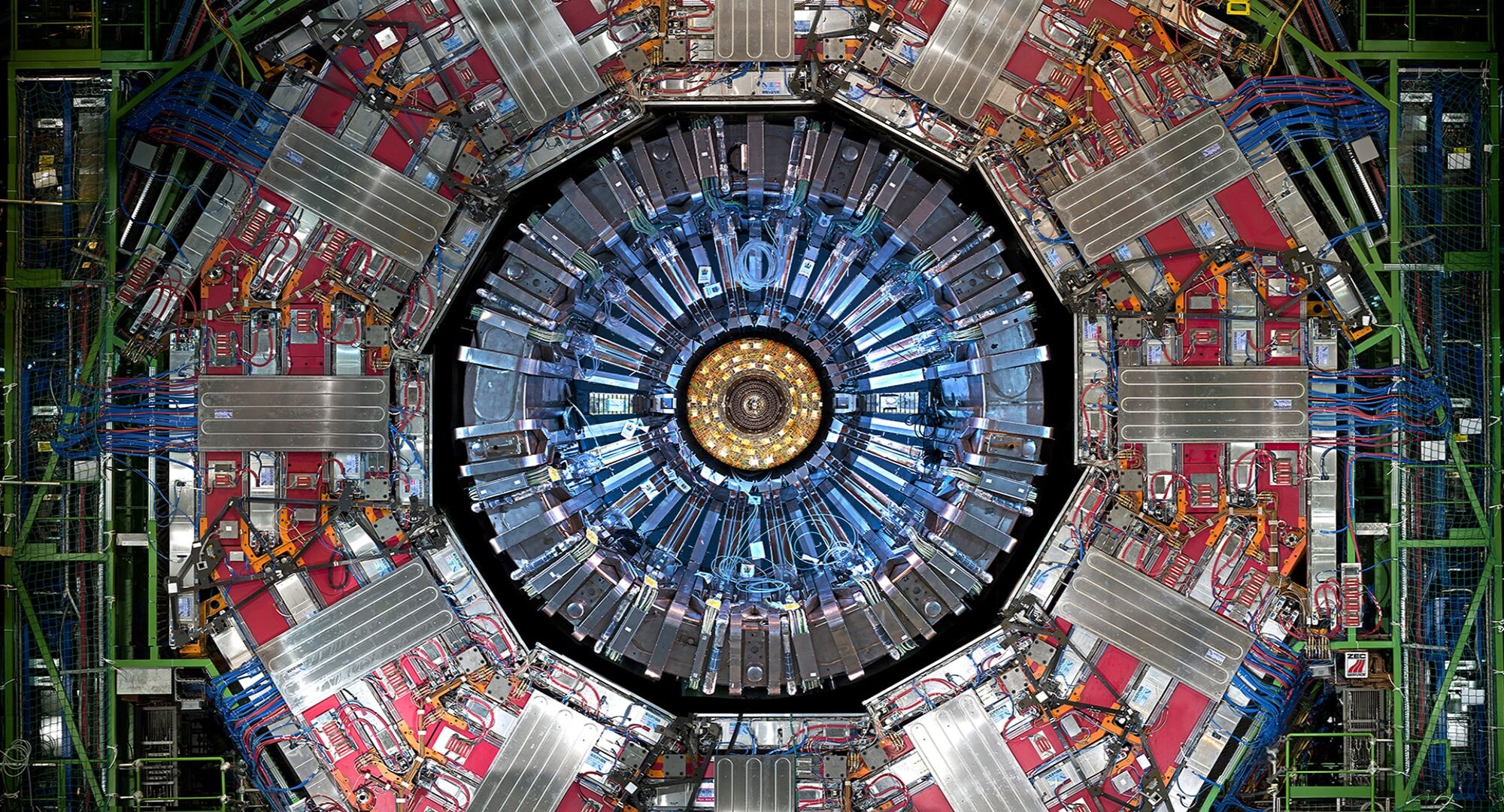The analysis of the physics data recorded by the CMS experiment is one of the key research topics at LIP. Our research interests include searches and studies of Electroweak processes, the Higgs boson, top quark, search for new physics, and flavor physics.
Maintenance and Operation
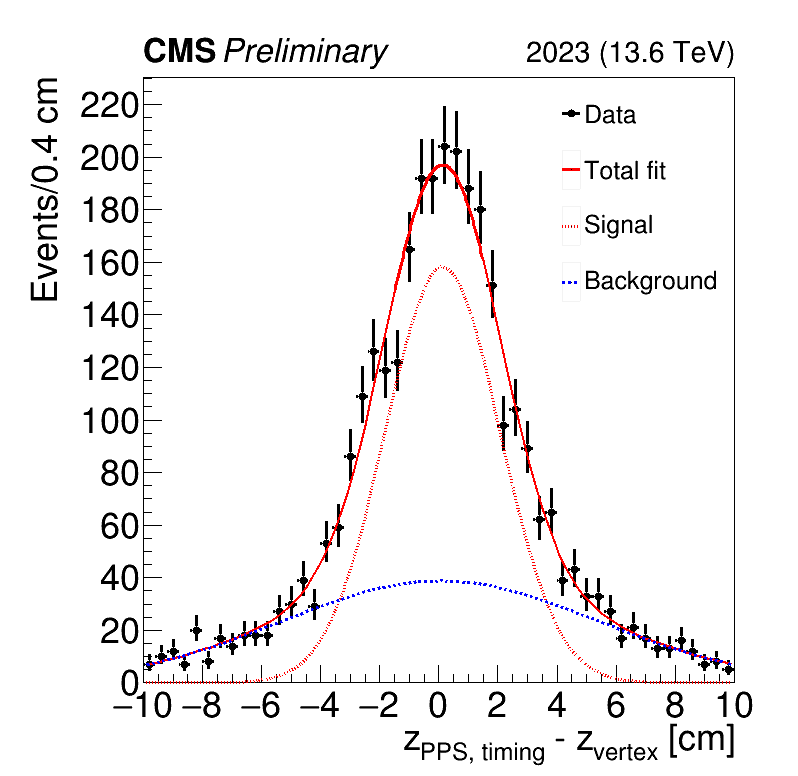
The group participates in the detector maintenance and operation.
- Precision Proton Spectrometer (PPS): project manager
- Other coordination positions: B-Physics Data Analysis, Standard Model PAG MC contact, MTD/BTL electronics systems, LHC HF WG
- Tagged Protons Physics Object Group
- Tau lepton identification and proton timing calibration [CMS-DP-2024-009, 2024]
- Group members are regularly selected to participate in Analysis Review Committees (ARC) and Detector Review Committees
- The group provides central shifts and EPR work according to the rules of the CMS collaboration
Lepton Flavour Universality (LFU)
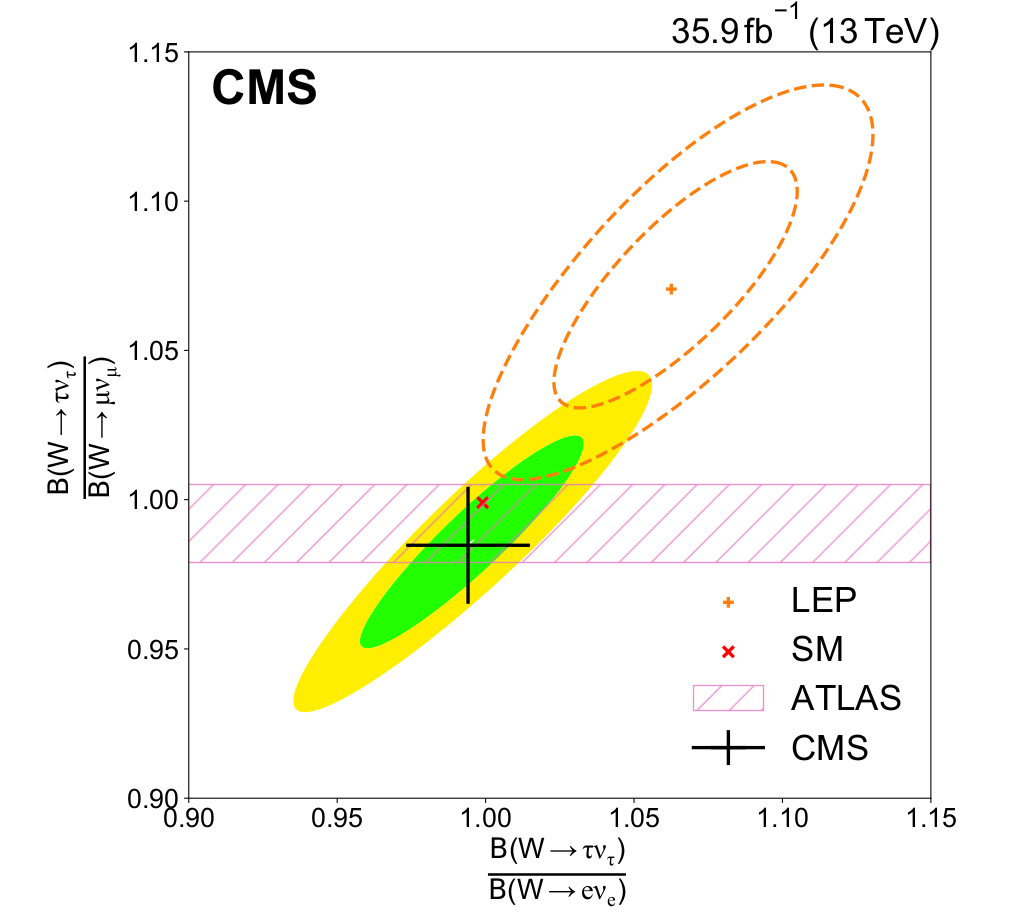
We perform a precision study of the lepton couplings to the W bosons in top quark events.
- Measured ttbar cross section in dilepton events containing a τ lepton [JHEP, 02:191, 2020]
- Different behaviour of the leptons (LFU violation) would be a clear signal of new physics
- Study top quark decays to obtain a pure sample of W-bosons in final states with all lepton families (e, μ, τ )
- Observables carefully crafted to minimise effects of leading systematics
- Machine Learning tools employed at different levels in the analysis
- Extracting a precise measurement to test the predictions on the Weak Nuclear interactions
Multiboson production
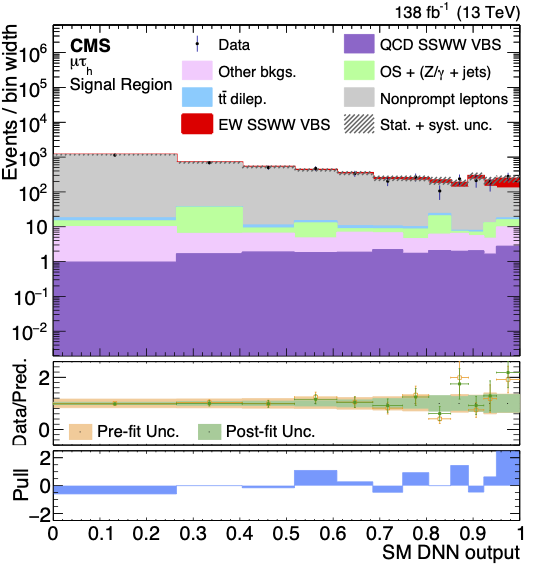
We study multiboson production in final states with hadronically decaying τ leptons. Studies are ongoing on Vector Boson Scattering (VBS) as well as inclusive production.
- Insight into EW and Higgs sectors can be achieved through measurements of VBS processes [Rev. Phys., 8:100071, 2022]
- τ leptons provide unexplored final states, which can increase our sensitivity to rare processes [arXiv:2410.04210]
- τ leptons have strong couplings to new particles in many BSM models
- τ leptons carry polarization information through their decay
- Rejection of hadronic jets misidentified as τ s
- Careful modelling of non-prompt backgrounds
Higgs boson properties
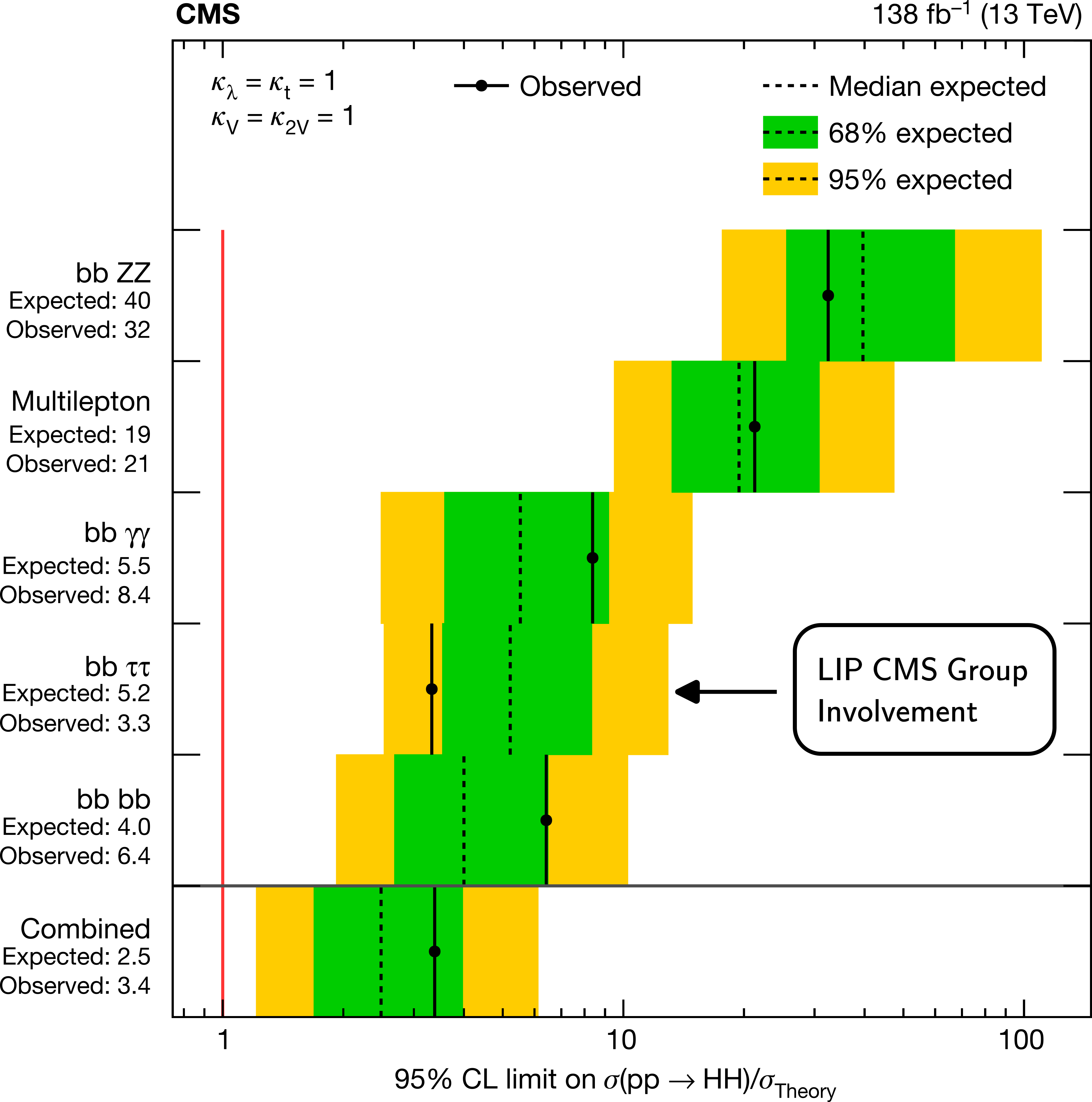
We explore the Higgs boson properties, studying the HH → bbτ τ process, the second most sensitive to the trilinear H self coupling λHHH The cross section for HH production in the SM is extremely small, thus escaping detection at the LHC so far.
- The structure of the Higgs scalar field potential and the strength of the H self-coupling are precisely predicted in the SM [Nature, 607(7917):60, 2022]
- Observed (expected) upper limit on the HH production cross section corresponding to 3.3(5.2) times the SM predictions [Phys. Lett. B, 842:137531, 2023]
- Contributions to the non-resonant analysis in the development of the DNN signal discriminant
- Search for resonant HH(bbτ τ ) pair production (in progress)
Rare decays in B-physics
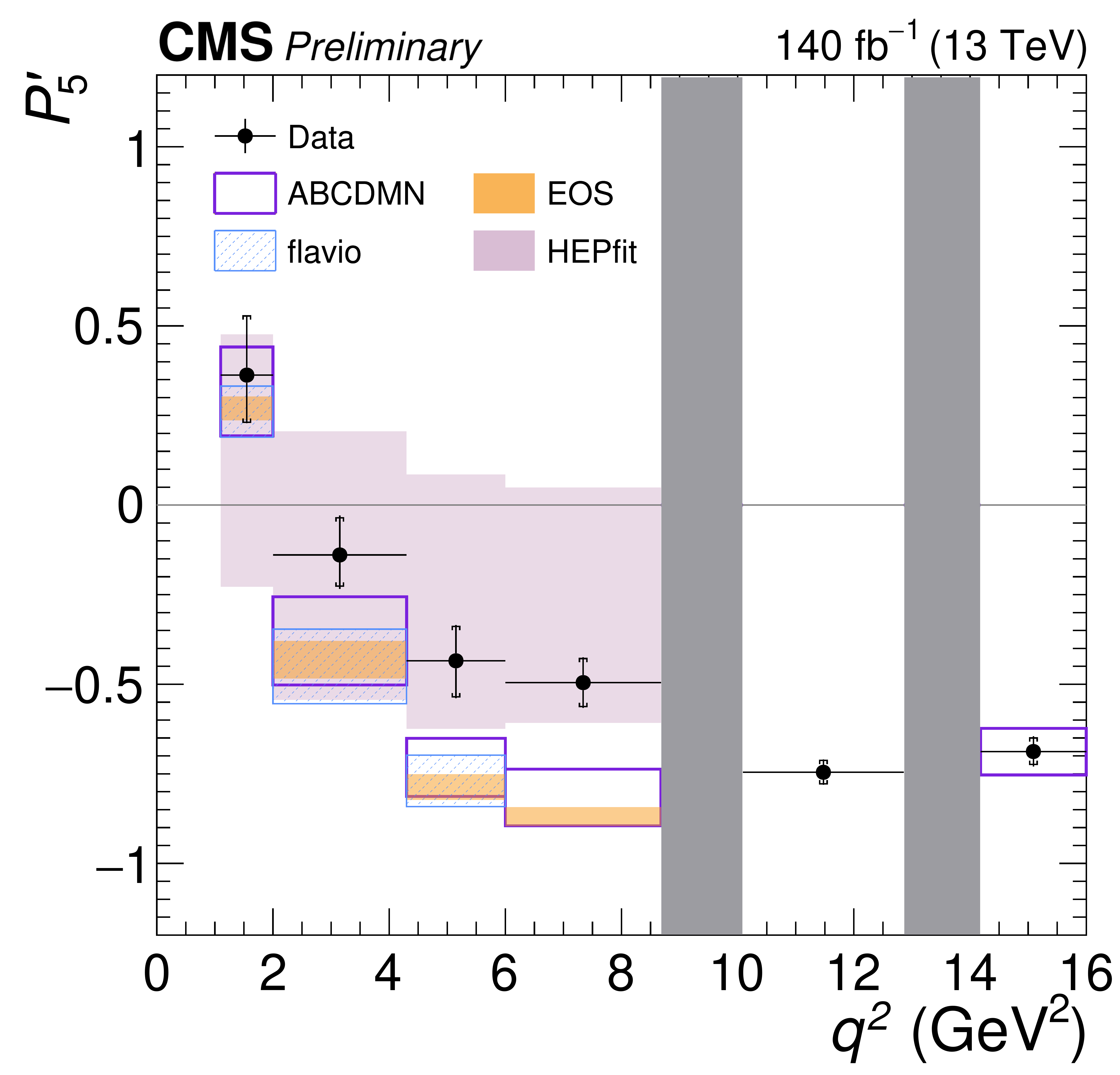
We study the full angular distribution of the B0→K∗0(K+π)μμ process [CMS-PAS-BPH-21-002].
- This rare decay is strongly suppressed in the SM and sensitive to contributions from BSM physics
- Fit of the angular variables and B0-candidate mass to access eight physics observables
- Results are among the most precise measurements of these observables, and present evidence of tension with SM predictions, the so-called Flavor Anomalies
Exclusive processes
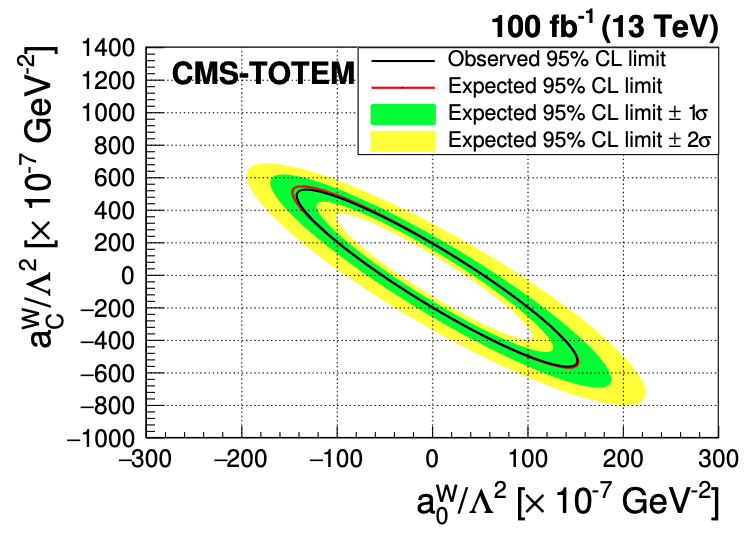
We search for exclusive process production in proton-proton collisions using intact forward protons reconstructed in near-beam detectors.
- Observation of proton-tagged central exclusive production of high-mass lepton pairs [JHEP, 07:153, 2018]
- Exclusive ttbar production [JHEP, 06:187, 2024]
- Search for high-mass γγ → W W/ZZ; No excess above the SM background prediction is observed, and upper limits are set on anomalous quartic gauge couplings (aQGCs) [JHEP, 07:229, 2023]
- Search for exclusive τ lepton pair production (in progress)
Probing the primordial fluid
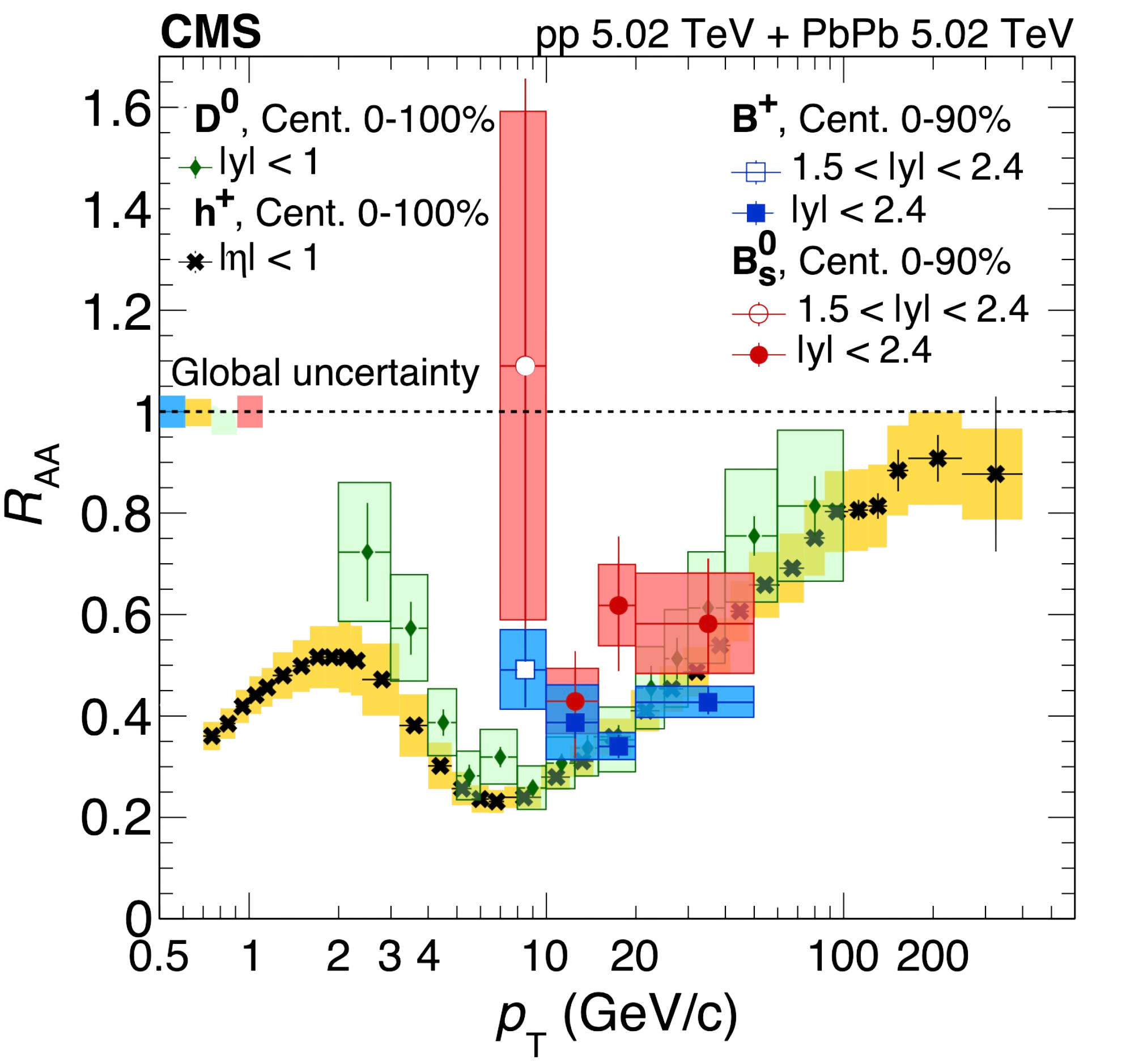
We explore heavy flavour as probes of the Quark-Gluon Plasma (QGP)
- B mesons reconstructed for first time in nuclear collisions [PLB, 829:137062, 2022]
- Measured relative production of B mesons in pp and PbPb (RAA) [arXiv:2409.07258]
- Probing QGP medium-induced effects on heavy quark hadronization
- Strangeness enhancement evidence in the beauty sector in QGP
- Investigating the nature of exotic hadron X(3872) using PbPb [PRL, 128(3), 2022]
Quarkonium production
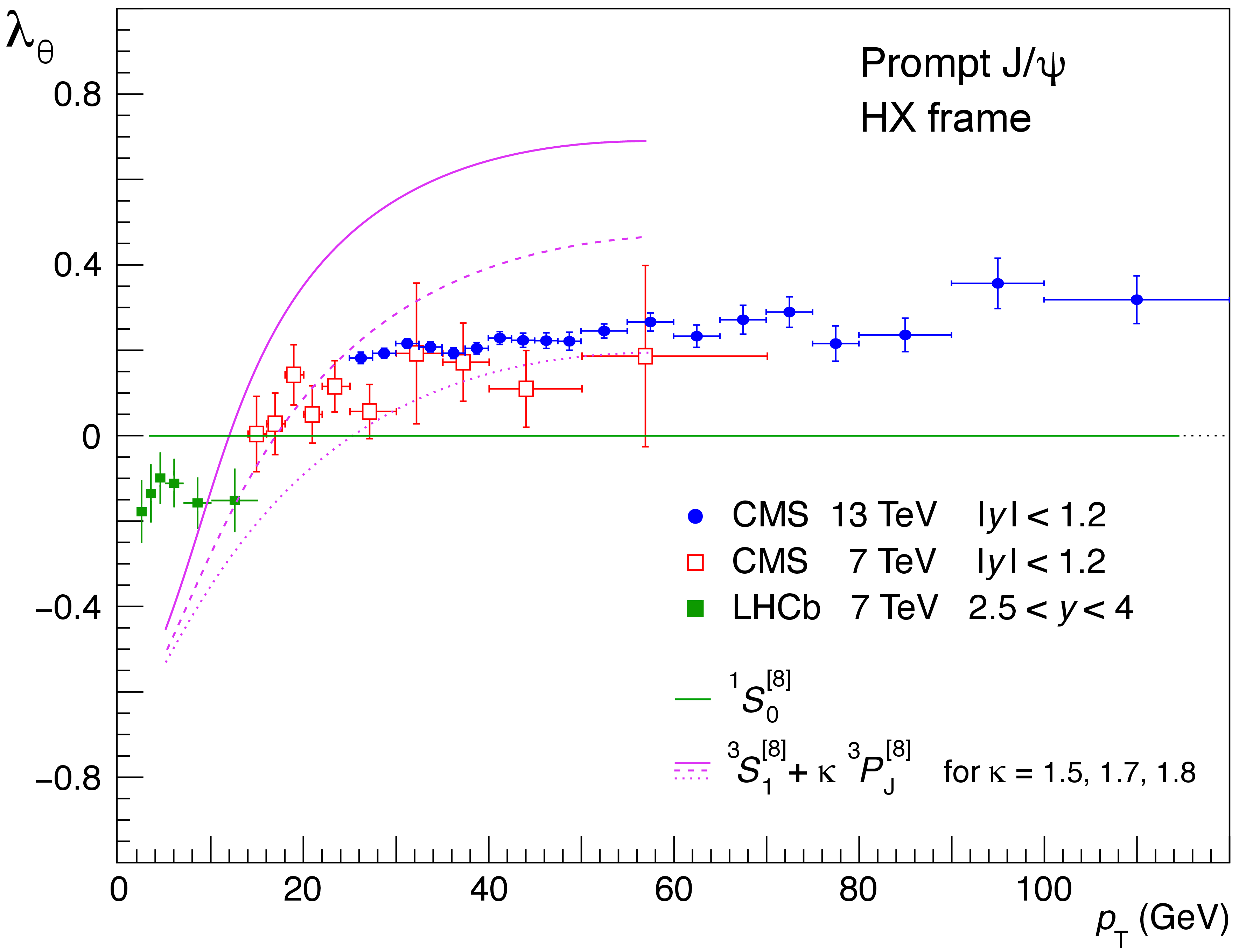
We study quarkonium polarization.
- Quarkonium production is a benchmark to understand quark binding into hadrons
- Polarization measurements highlight features that may hide behind inclusive measurements
- Particle Polarization in HEP; An introduction on vector particle production at the LHC: [Lecture Notes in Physics 1002 (2023)]
- Polarization measurements of prompt χc1 and χc2 [PRL 124 (2020) 162002], and of J/ψ and ψ(2S) [PLB 858 (2024) 139044]
Supersymmetry (SUSY) and the Dark Sector
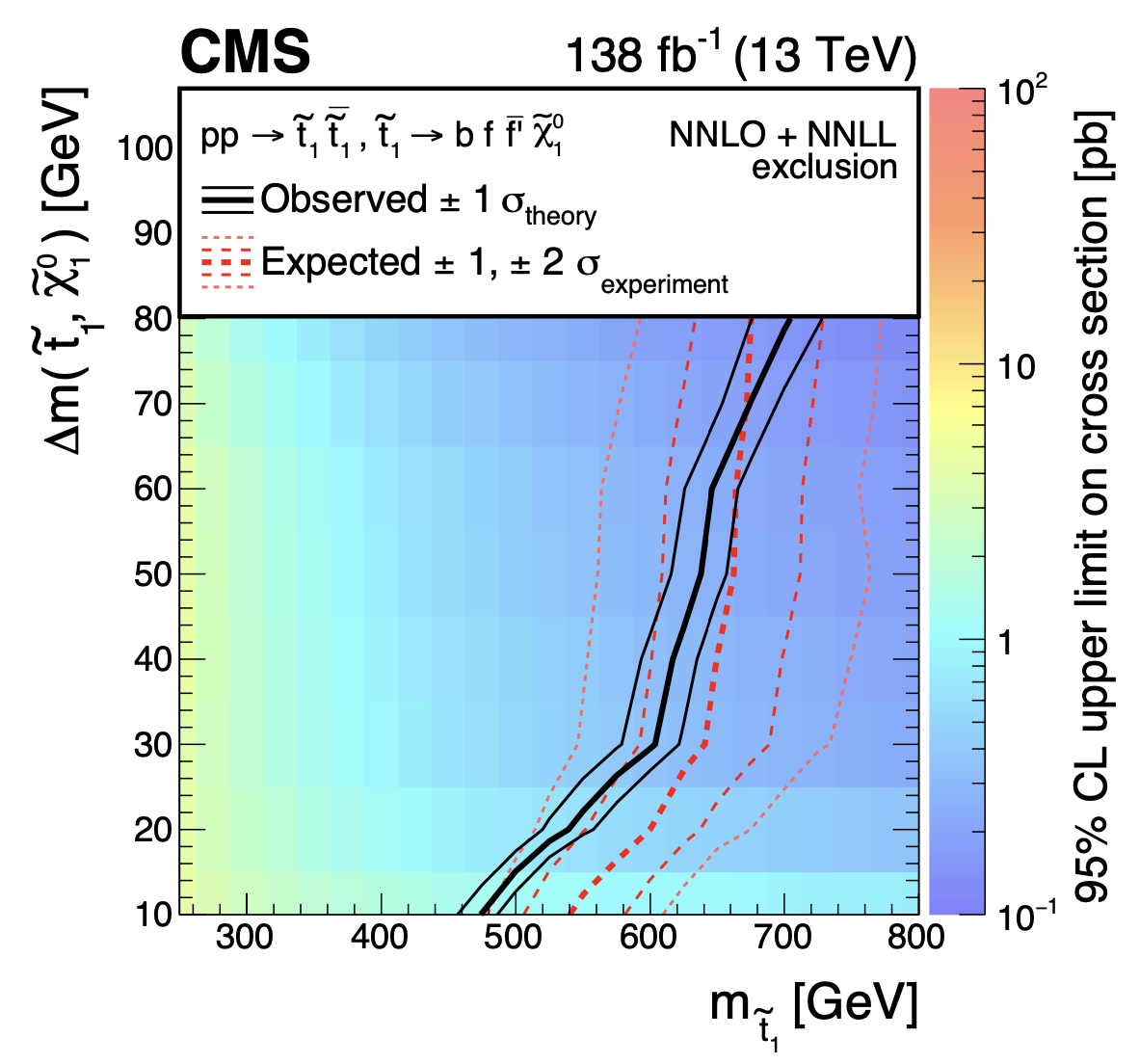
We search for SUSY and dark matter at unprecedented collision energies [arXiv:2405.13778].
- The SM explains only 5% of the Universe and is not able to answer other outstanding questions. It cannot account for the invisible “dark matter”.
- We search for SUSY in events with at least one soft lepton, low jet multiplicity, and missing transverse momentum in pp collisions at 13 TeV
- We explored a compressed mass spectrum
where the mass difference between the
produced stop and the lightest SUSY particle
(LSP) is smaller than the W boson mass - No significant excess is observed above the
expectation from SM processes. Set limits on
top squark masses up to 480 and 700 GeV
[JHEP, 06:060, 2023]
Some of the earlier studies are listed below.
Top Quark Physics
The top quark is the heaviest of all known elementary particles. With a mass close to that of an atom of gold, it has a mass about 40 times heavier than the b-quark and it is heavier than the W boson, the top quark decays to a W boson and a b-quark with a branching fraction close to 100%. The top quark is a fundamental particle with a mass close to the electroweak symmetry breaking (EWSB) scale, and it may play an important role in the understanding of the EWSB mechanism. Furthermore, the large top quark mass implies a large coupling to the Higgs boson, thus establishing a privileged link to the Higgs sector. Due to its short lifetime, the top quark decays before hadronization and it offers the unique opportunity to study the properties of a bare quark which are preserved in the decay chain and transferred to its decay products. Measurements of the relative rates and study of the properties of top quark final states may provide constraints for new physics processes.
At LIP, researchers have contributed with a leading role to several top quark studies, including the cross section and mass measurements in the dilepton channel, measurement of the top quark pair cross section with taus, and studies of the heavy flavor content of top quark events.
Cross section: Top quark pair production cross section is measured in proton-proton collisionsat 7 TeV in a data sample corresponding to an integrated luminosity of 36 inverse picobarns. The measurement is performed in events with two leptons (electrons or muons) in the final state. Results of the cross section measurement in events with and without b-quark identification are obtained and combined.
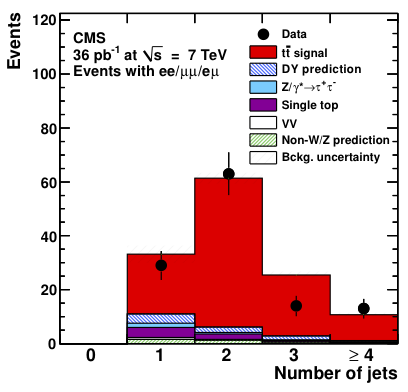
more info:
Measurement of the ttbar production cross section in the dilepton channel at 7 TeV
Top quark mass (1st measurement): The top quark mass is measured in proton-proton collisions at 7 TeV in a data sample corresponding to an integrated luminosity of 36 inverse picobarns. The measurement is performed in events with two leptons (electrons or muons) in the final state. Top quark mass is reconstructed with a fully kinematic analysis (KINb method).
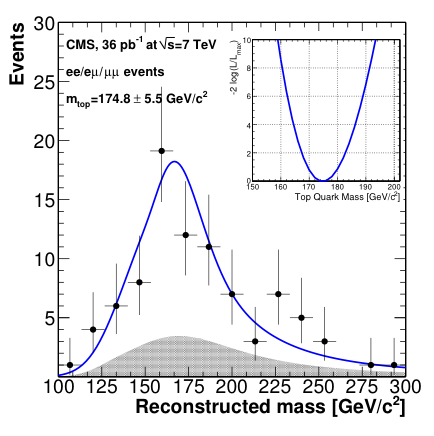
more info:
Measurement of the top quark mass in the dilepton channel at 7 TeV
Top quark mass: The top-quark mass is measured in proton-proton collisions at 7 TeV using a data sample corresponding to an integrated luminosity of 5.0 inverse femtobarns. The measurement is performed in the dilepton decay channel and the mass is determined to be 172.5±0.4 (stat.)±1.5 (syst.) GeV.
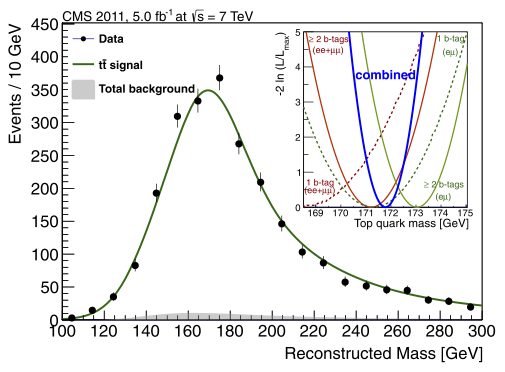
more info:
Measurement of the top quark mass in ttbar events with dilepton final states at 7 TeV
Taus: The top quark pair production cross section is measured in dilepton events with one electron or muon, and one hadronically decaying τ lepton. This is the first measurement of the cross section explicitly including tau leptons in proton-proton collisions at 7 TeV.
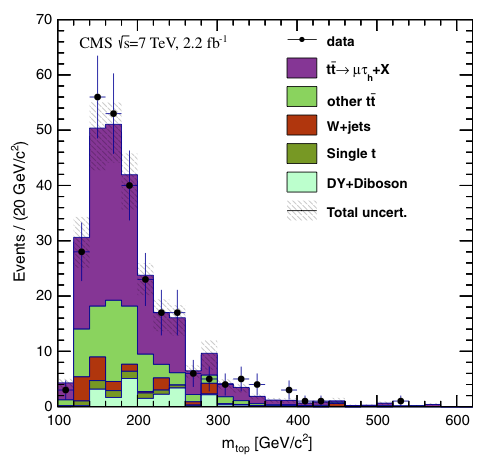
more info:
Measurement of the ttbar cross section at 7 TeV in dilepton final states containing a tau
Heavy flavor content (Vtb): The ratio of the top quark branching fractions R=B(t→Wb)/B(t→Wq), (with q = b, s, d), is measured in the ttbar dilepton final state.
The cross section is measured by fitting the observed jet multiplicity, and by counting the number of b jets per event, an unconstrained value of R=1.014 +/- 0.003 (stat.) +/- 0.032 (syst.) is measured. A lower limit R>0.955 at the 95% confidence level is obtained after requiring R<=1, and a lower limit on the Cabibbo-Kobayashi-Maskawa matrix element |Vtb|>0.975 is set at 95% confidence level. The result is combined with the t-channel single-top-quark cross section to determine the top quark total decay width, Gamma[t]=1.36 +/- 0.02 (stat.) +0.14/-0.11 (syst.) GeV.
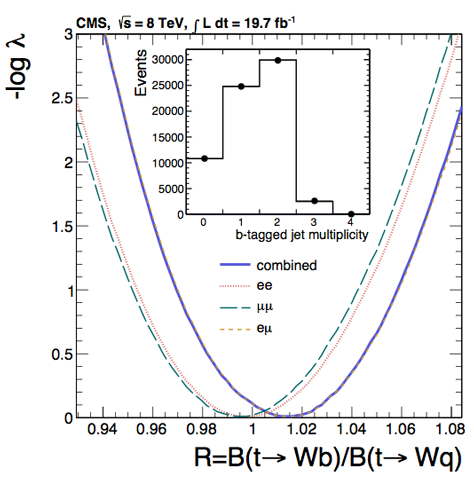
more info:
Measurement of the ratio B(t→Wb)/B(t→Wq)
Taus at 8 TeV: The top quark pair production cross section is measured in final states with one electron or muon, and one hadronically decaying tau lepton. Using the full Run 1 data sample at 8 TeV, the measured cross section, 257 +/- 3 (stat) +/- 24 (syst) +/- 7 (lum) pb, assuming a top-quark mass of 172.5 GeV, is consistent with the standard model prediction.
This is the most accurate measurement in this final state.
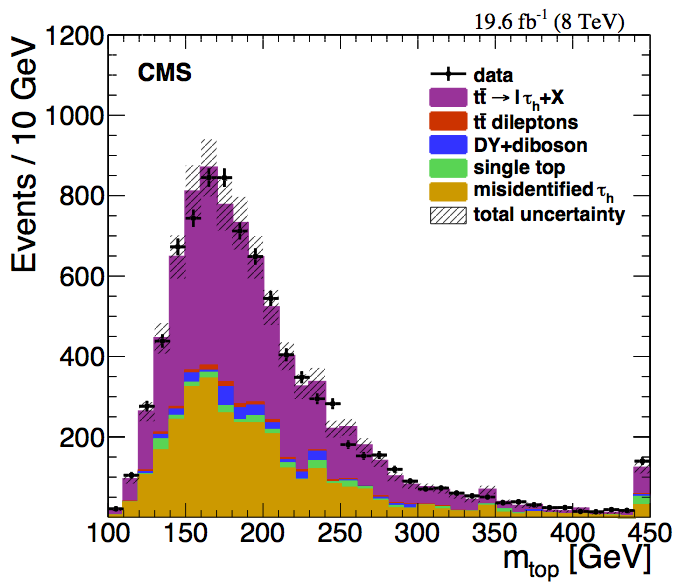
more info:
Measurement of the ttbar cross section at 8 TeV in dilepton final states containing one tau lepton
Quantum Chromodynamics
The measurement of isolated prompt photon production in proton-proton collisions provides a test of perturbative quantum chromodynamics (pQCD) and the possibility to constrain the parton distribution functions (PDF) of the proton. Such a measurement complements deep-inelastic scattering, Drell-Yan pair production, and jet production measurements. At the LHC, a significant increase of centre-of-mass energy with respect to previous collider experiments allows the exploration of new kinematic regions in the hard-interaction processes in hadron-hadron collisions. Isolated prompt photon production also represents a background to searches for new phenomena involving photons in the final state.
Researchers at LIP had a leading role in the first measurement of the inclusive photon cross section at the LHC.
Photons: The differential cross section for the inclusive production of isolated prompt photons has been measured as a function of the photon transverse energy in pp collisions at 7 TeV. The data sample corresponds to an integrated luminosity of 2.9 inverse picobarns. Photons are required to have a pseudorapidity <1.45 and transverse energy >21 GeV. The measured cross section is found to be in agreement with next-to-leading-order perturbative QCD calculations.
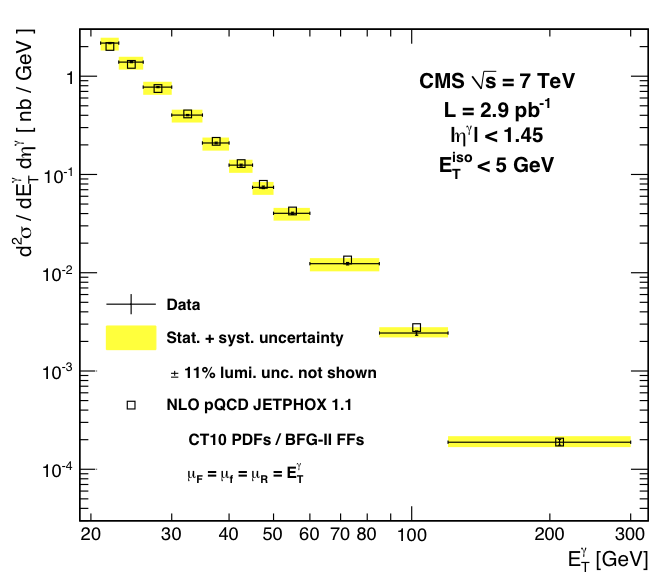
more info:
Measurement of the isolated prompt photon production cross section at 7 TeV
Higgs Physics
The Higgs boson has a special role in the SM. It is the only scalar particle, and via the Higgs mechanism it is responsible for the mass of all elementary particles. On July 4, 2012, the CMS and ATLAS experiments announced the discovery of a new particle whose properties seem to be compatible with the SM Higgs boson. Researchers at LIP played a leading role in the search for SM Higgs decays into a pair of photons, and are studying some of its properties.
In the Minimal Supersymmetric extension of the SM (MSSM), the Higgs sector contains five particles: three neutral (the CP-even h0 and H0, the pseudo-scalar A0) and two charged (H±) Higgs bosons. Whereas the neutral Higgs boson is compatible with both the SM and the MSSM, the detection of a charged Higgs boson would unequivocally point to new physics beyond the SM. Researchers at LIP have a leading role in the search for the charged Higgs.
Higgs search: A search for a Higgs boson decaying into two photons is performed using a dataset from pp collisions at 7 TeV, which corresponds to an integrated luminosity of 4.8 fb-1. The expected exclusion limit at 95% confidence level is between 1.4 and 2.4 times the standard model cross section in the mass range between 110 and 150 GeV. The analysis of the data excludes, at 95% confidence level, the standard model Higgs boson decaying into two photons in the mass range 128 to 132 GeV. The largest excess of events above the expected standard model background is observed for a Higgs boson mass hypothesis of 124 GeV with a local significance of 3.1 standard deviations.
more info:
Search for the standard model Higgs boson decaying into two photons at 7 TeV
Higgs (fermiophobic and 4-generations): Searches are reported for Higgs bosons in the context of either the SM extended to include a fourth generation of fermions (SM4) with masses of up to 600 GeV or fermiophobic models. For the former, results from three decay modes (tau tau, WW, and ZZ) are combined, whilst for the latter the diphoton decay is exploited. The analysed data correspond to integrated luminosities of up to 5.1 inverse femtobarns at 7 TeV and up to 5.3 inverse femtobarns at 8 TeV. The recently observed boson with a mass near 125 GeV is not consistent with either an SM4 or a fermiophobic Higgs boson.
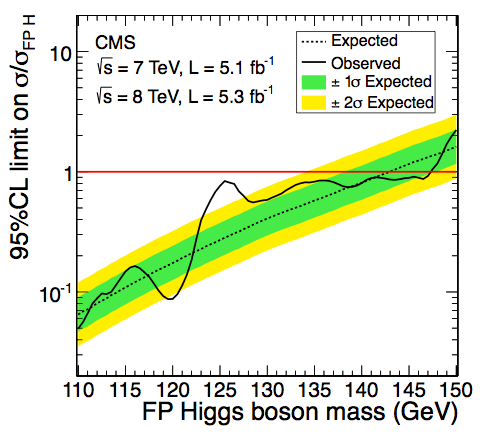
more info:
Searches for Higgs bosons at 7 and 8 TeV in the context of four generations and fermiophobic models
Higgs discovery: The diphoton invariant mass distribution with each event weighted by the S/(S+B) value of its category. The lines represent the fitted background and signal, and the coloured bands represent the ±1 and ±2 standard deviation uncertainties in the background estimate. The inset shows the central part of the unweighted invariant mass distribution.
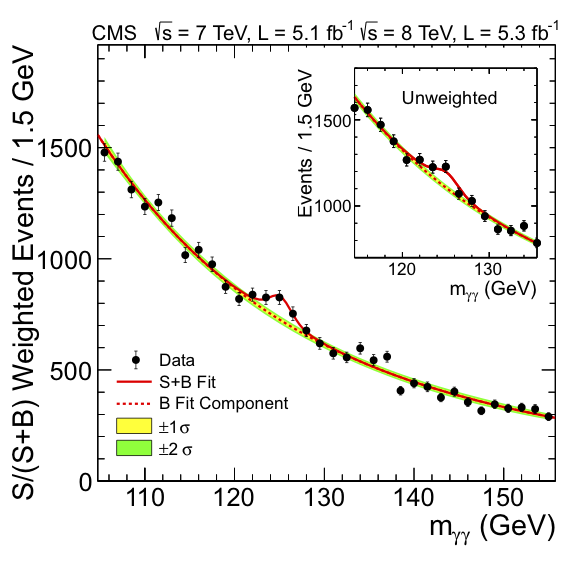
more info:
Observation of a new boson at a mass of 125 GeV
Higgs couplings: The 68% CL contours for the test statistic in the (κ_V versus κ_F) plane for individual channels (coloured regions) and the overall combination (solid thick lines). The thin dashed lines show the 95% CL range for the overall combination. The black cross indicates the global best-fit values. The diamond shows the SM Higgs boson point (κV,κF) = (1, 1). The point (κV,κF) = (1, 0), indicated by the circle, corresponds to the fermiophobic Higgs boson scenario. The plot allows for different signs of κV and κF.
Higgs (LHC cross section): This document presents a framework in which the coupling structure of a Higgs-like particle can be studied. After discussing different options and approximations, recommendations on specific benchmark parametrizations to be used to fit the data are given.
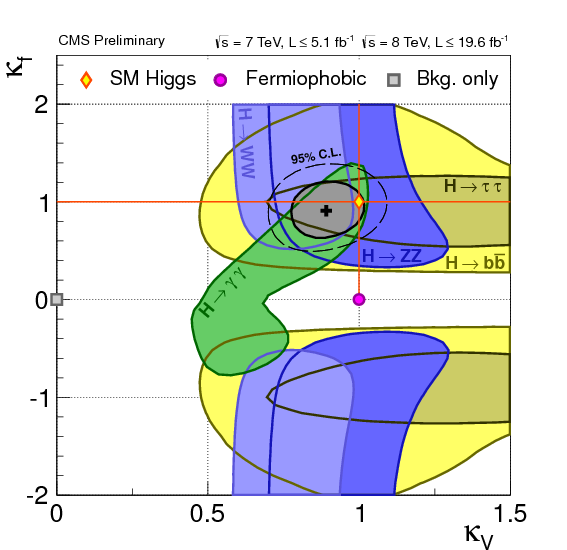
more info:
LHC HXSWG recommendations to explore the coupling structure of a Higgs-like particle
Higgs (properties): This report summarizes the results of the activities in 2012 and the first half of 2013 of the LHC Higgs Cross Section Working Group. The main goal of the working group was to present the state of the art of Higgs Physics at the LHC, integrating all new results that have appeared in the last few years. After the discovery of a Higgs boson at the LHC in mid-2012 this report focuses on refined prediction of SM Higgs phenomenology around the experimentally observed value of 125-126 GeV, refined predictions for heavy SM-like Higgs bosons as well as predictions in the Minimal Supersymmetric SM and first steps to go beyond these models. The other main focus is on the extraction of the characteristics and properties of the newly discovered particle such as couplings to SM particles, spin and CP-quantum numbers etc.
more info:
Handbook of LHC Higgs cross sections: Higgs properties
Charged Higgs: Results are obtained on a search for a light charged Higgs boson that can be produced in the decay of the top quark and which, in turn, decays into tau leptons. Upper limits on the branching fraction B(t→H+b) in the range of 2-4% are established for charged Higgs boson masses between 80 and 160 GeV, under the assumption that the charged Higgs decays to a tau and a neutrino.

more info:
Search for a light charged Higgs boson in top quark decays
Charged Higgs (update): Updated results are presented in the search for a light charged Higgs boson that can be produced in the top quark decay t→H+b with subsequent decay of the charged Higgs to a tau and a neutrino. Upper limits on the branching fraction B(t→H+b)in the range of 2-3% are established for charged Higgs boson masses between 80 and 160 GeV.
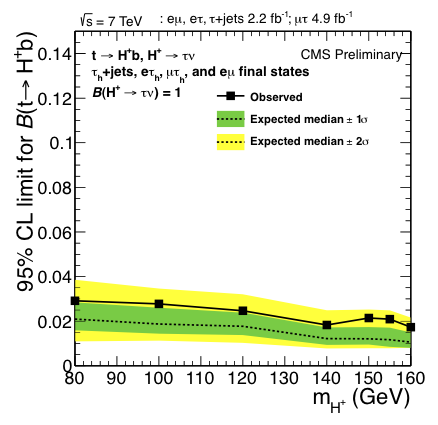
more info:
Updated search for a light charged Higgs boson in top quark decays
Charged Higgs (light and heavy): A search for a charged Higgs boson is performed with the full Run1 data sample in pp collisions 8 TeV. The charged Higgs boson is searched for in top quark decays t→H+b (light charged Higgs), and in the direct production pp→t(b)H+ (heavy charged Higgs). No signal is observed and 95% confidence level upper limits are set on the charged Higgs boson production. The combination of all considered decay modes and final states is used to set exclusion limits in the m(H+)-tan(beta) parameter space in different MSSM benchmark scenarios.

more info:
Search for a charged Higgs boson at in pp collisions at 8 TeV
Search for Supersymmetry
Supersymmetry (SUSY) is an attractive and elegant theory of physics beyond the SM. It naturally solves the hierarchy problem by associating with each SM particle a partner with the same gauge interactions. Additionally, it predicts the evolution of gauge couplings leading to the unification of forces. Furthermore, in the case the lightest SUSY particle is stable, SUSY predicts weakly interacting particles which are natural candidates for the observed Cold Dark Matter. Furthermore, it solves the problem of quadratic divergences in the SM and yields a natural explanation for the Higgs mechanism. However, there is no experimental evidence for supersymmetry in nature yet.
In the case SUSY is a symmetry of nature, the mass splitting between pairs of squarks is proportional to the SM quark mass; since the top quark is the heaviest SM quark, the lightest stop quark is the lightest squark, thus, the most easily observable at the LHC. LIP researchers have been searching for the stop quark in the “lepton plus jets” final state. Data collected by the CMS experiment at the LHC have been used to search for the lightest supersymmetric partner of the top quark produced in pairs, in final states with a single muon/electron plus jets and missing transverse energy. Event selection was optimized, and the backgrounds determined, wherever possible, directly from data.
Flavor Physics
Since the revolutionary discovery of the J/Psi meson, quarkonia, bound states of heavy quark-antiquark pairs, have played a crucial role in understanding fundamental interactions. Being the hadronic-physics equivalent of positronium, they allow detailed study of some of the basic properties of quantum chromodynamics (QCD), the theory of strong interactions. In particular, the angular decay could provide detailed information on their formation.
At LIP, researchers played a leading role in measuring the polarization of the J/Psi and Y states.

The polarizations of the Υ(1S), Υ(2S), and Υ(3S) mesons are measured in proton-proton collisions at 7 TeV. No evidence of large transverse or longitudinal polarizations is seen in the explored kinematic region.
more info:
Measurement of the Y(1S), Y(2S), and Y(3S) polarizations at 7 TeV
The polarizations of prompt /Psi and Psi(2S) mesons are measured in proton-proton collisions. The polarization parameters are measured from the dimuon decay angular distributions in different polarization frames. No evidence of large transverse or longitudinal polarizations is seen.
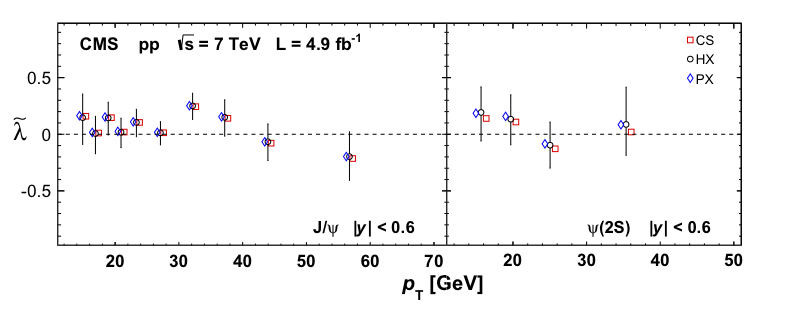
more info:
Measurement of the prompt J/Psi and Psi(2S) polarizations at 7 TeV
Particle Identification
Particle Identification is fundamental to particle physics experiments. Particles are characterized based on the information left in passing through a particle detector. At CMS, different particles, both charged and neutral, such as photons, electrons and muons, taus and jets, and the neutrinos, are reconstructed with sophisticated algorithms. Particle identification algorithms aim at reducing backgrounds and improving measurement resolutions, and they are essential tools for data analyses.
Researchers at LIP have contributed to the studies of electron/photons, b-jet, and tau lepton reconstruction and identification.
b-jets: At the LHC, the identification of jets originating from b quarks is important for searches for new physics and for measurements of standard model processes. A variety of algorithms has been developed by CMS to select b-quark jets based on variables such as the impact parameters of charged-particle tracks, or the properties of reconstructed decay vertices. The performance of these algorithms has been measured using data from proton-proton collisions and compared with expectations based on simulation. The data used in this study were recorded in 2011 at 7 TeV. The efficiency for tagging b-quark jets has been measured in events from multijet and top quark pair production.
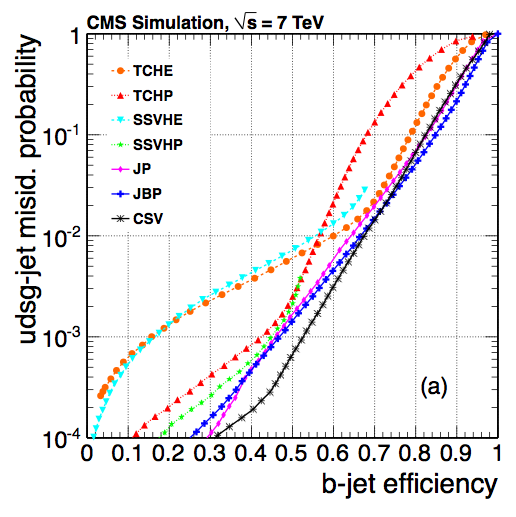
more info:
Identification of b-quark jets
Tau lepton: The performance of tau lepton reconstruction and identification algorithms is studied using a data sample of proton-proton collisions at 7 TeV. The tau leptons that decay into one or three charged hadrons, zero or more short-lived neutral hadrons, and a neutrino are identified using final state particles reconstructed in the CMS tracker and electromagnetic calorimeter. The reconstruction efficiency of the algorithms is measured using tau leptons produced in Z-boson decays. The tau lepton misidentification rates for jets and electrons are determined.
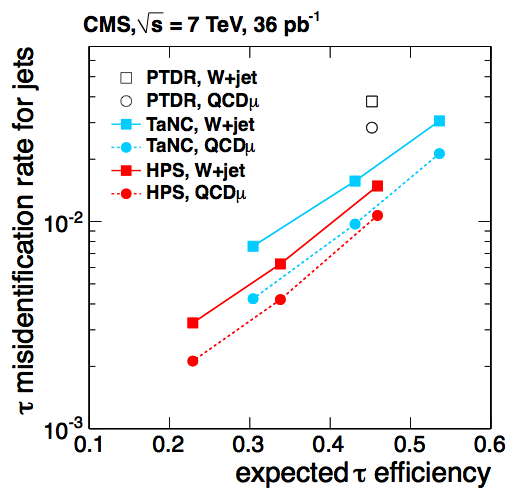
more info:
Performance of tau lepton reconstruction and identification
Electrons: A study of the electron identification and selection efficiency of the L1 trigger algorithm has been performed using the combined ECAL/HCAL test beam data. A detailed discussion of the electron isolation and its impact on the selection efficiency is presented. The L1 electron algorithm is studied for different beam energies and the results indicate that efficiencies of 98% or more can be achieved for electrons with energies between 15 and 100 GeV. The fraction of charged hadrons with energies from 3 up to 100 GeV rejected by the L1 electron trigger algorithm is estimated to be larger than 93%.
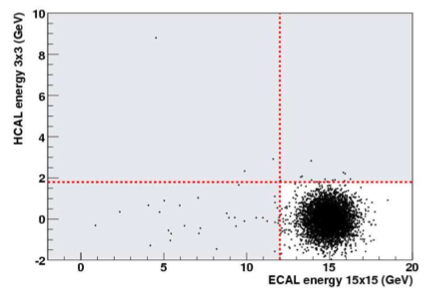
more info:
Study of the electron trigger efficiency
L1 trigger: The CMS Level-1 trigger was used to select cosmic ray muons and LHC beam events during data-taking runs in 2008, and to estimate the level of detector noise. Using data from extended cosmic ray runs, the muon, electron/photon, and jet triggers have been validated, and their performance evaluated. Efficiencies were found to be high, resolutions were found to be good, and rates as expected.
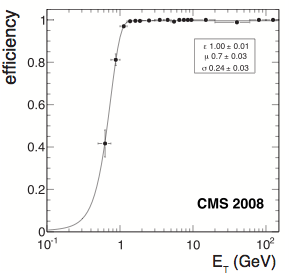
more info:
Performance of the Level-1 trigger with cosmic rays and LHC beams
